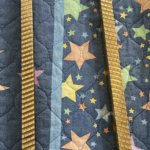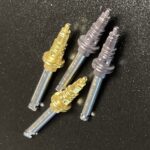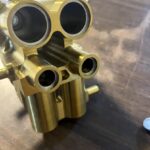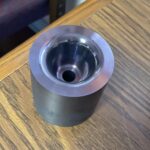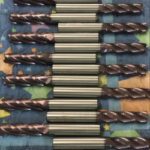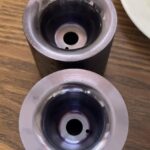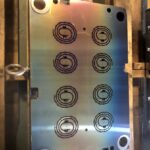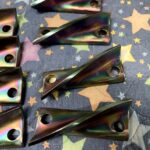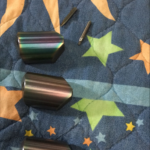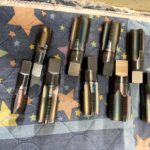Overview of PVD Coating Development and Coating Properties
The last decades, advances in coating deposition technologies have led to the development of nano-structured coating materials with unique properties, such as superhardness (defined as hardness H>40 GPa) in combination with high toughness. Coatings prepared by plasma assisted deposition are often known to exhibit increased hardness compared to their corresponding bulk counterparts, due to factors such as grain size refinement, high growth-defect density and residual compressive stress, induced by the deposition process. As the demand for PVD coating grows, it becomes increasingly apparent that the single element coatings are not capable to meet the requirements of the diverse applications of modern day machinery. PVD coating industry is constantly evolving to meeting the manufacturing demands, it has shifted from general purpose binary nitride coatings, to engineered multi-elements, Quaternary coatings for specific conditions, and it is now favoring the superlattice coatings, that are comprised of multi-elements, components, and nanometer scaled layered/hbrid structures, The engineered coatings incorporate numerous thin films, comprised of a unique coating system, which yields superior tribological properties. The selection of the various phases of such coating processes and the “blueprint” in which they are presented provides an important control parameter. In addition, many applications require that the coating process operates at a multi-functional mode, such as coupling temperature and oxidation resistance, while providing a low coefficient of friction under adverse conditions. Often times, these mechanical, chemical and physical demands cannot be met with monolithic thin film. PVD coating uses multi-component (layered) coatings arranged in specific designs to provide the properties needed. These coating systems typically comprise of the following layers: -An adhesion layer that ensures the bonding between the substrate and the coating system -An intermediate layer that supports the synergy between the adhesion layer and the outer functional layer -A functional layer possesses favorable properties on contact with the working component and environment Usually these three layers are applied by different PVD methods, depending upon specific needs and requirements. By filtering through the advantages and disadvantages of each coating method, choosing an appropriate coating selection, and incorporating different levels of ion bombardment energy through bias control we are able to come up with the optimal surface coating. There are also methods to combat the complexity of the multilayer deposition, by offering multi-element, monolith layer coating. This method offer better coating process control than the multi-layer deposition. Instead of igniting many element targets in systematic way, several alloyed targets are able to achieve the same task. Thin hard PVD coatings are today frequently used in order to improve the tribological performance of forming tools, cutting tools, and machine elements. In all these applications the surface roughness of the coated part is of utmost importance since it will affect the friction, wear and fatigue characteristic of the tribo-system. Since most PVD coatings are significantly harder than the counter surface material a high coating surface roughness will result in a high wear rate of the counter surface. In general, a high coefficient of friction is due to a significant contribution from the ploughing component of friction because protruding surface asperities (macroparticles, etc.) of the harder rough coating surface will also increase the material pick-up tendency which may cause problems such as galling in metal forming application. A pronounced surface roughness will also increase the tendency to crack initiation and surface fatigue of the coated part due to high contact stresses at the asperities. Finally, a rough substrate surface may also result in problems related to poor adhesion, i.e. coating spalling. In order to reduce these problems, PVD coatings of less hard materials such as diamond like carbon and carbon rich metal carbide based structures can be used. These coatings are gentler to the counter surface and show a beneficial friction coefficient towards many engineering materials also under dry sliding conditions. The mechanisms controlling the low friction properties of these coatings are not fully understood by the industry and they are strongly dependent of the tribo-system. However, most of the studies suggest that the lubricity of these coating(s) is/are determined by interfacial tribo-films generated during sliding (i.e. oxides that are formed during application) and not by the properties of the coatings themselves.Traditional Binary Nitride Coatings (MexNy) were the first PVD commercial PVD coatings to be on the market.
| TiN (Titanium Nitride)
Titanium Nitride is the most commercially available PVD coatings on the market. It is the first general purpose PVD coating to be successfully applied and it remains the most recognized PVD coating by customers. This coating is distinguished by its attractive gold finish.
TiN coating is ideal for a wide range of applications that require increasing the overall hardness, heat resistance, oxidation resistance, and lubricity of a substrate. TiN is also biocompatible and has been approved by the medical industry. For years, TiN has been used as the finishing touches for implants and surgical devices. Consult our application engineer for more information.
|
| CrN (Chromium Nitride) and ZrN (Zirconium Nitride) These binary nitrides with its superior resistance to adhesive wear, chemical corrosion, and oxidation. Its low coefficient of friction makes it ideal for die cast, molding components applications that require reduction of, galling during process. They are also ideal for medical instruments due to its corrosion and oxidation resistance that exceed that of the TiN (Titanium Nitride). These coatings had been replaced by the ZN54 product line in many applications because of its superlattice coating structure that comprises of multi-layer, multi-element structure, while customer have reported the new oxynitride coating series has been shown to perform by than ZN54 series in the same applications. Contact us for further information and assistance. |
In attempt to increase the hardness and durability by alloying the Binary Nitrides with additional elements such Ternary Nitride Coatings (Me1xMe21-x) are the coatings choices for applications that demand more performance than the Binary Nitrides.
| TiCN (Titanium CarboNitride) Carbide and Nitride coatings are well suited for increasing the performance of tools due to their high hardness, thermal stability, and chemical inertness. In fact, spurred by the improved functionality over titanium nitride, there has been large interest to improve the formulation of the commercial TiCN coating. Ti(CN) coatings exist in a rather broad composition range. Not only can coatings be produced with composition TiCxN1-x, where x ranges from 0 to 1 and Carbon can partly substitute for the smaller Nitrogen atoms in the face-centered cubic structure, but a high fraction of vacancies can also exist on the carbon or nitrogen sites, the different sizes of the new atoms in the crystal causes a strain in the crystal, which leads the increase in hardness. The incorporation of the carbon molecules into the TiN coating structure, resulting TiCN coating that exhibits excellent increased hardness and wear resistance, exceeding that of TiN coating. TiCN is the ideal coating for machining, stamping, and forming high carbon steel or tool steel, as well as other abrasive materials. The gray finish of TiCN has also been used for decorative applications. TiCN has been traditional used for various cutting, milling and general machining of high strength steel and stainless steels. Furthermore, it is used to protect the punching, stamping and forming tools. Its hardness has been widely used for abrasion, and wear resistance applications. Customers have found that under the same conditions, the newly designed oxynitride coating shows over 30% increase in tool life compare to TiCN coating; while MTBB shown to increase inversely, please contact us for further information. |
| TiAlN / AlTiN (Titanium Aluminum Nitride / Aluminum Titanium Nitride)
In the last decade, coatings have become the standard choice for many applications. Their high level of hardness, exceptional wear resistance, and oxidation prevention under high temperature make them ideal especially for high speed dry cutting operations. However, the disadvantage of this coating system is the higher coefficient of friction that it exhibits compared to other coatings.
Dry lubricant top coating such as WC, MoS2 have been used as top coats, to improve the coefficient of friction with limited durability.
In addition, other low coefficient elements have been deposited in combination with the coating matrix. In other cases, low coefficient element(s) is/are alloyed with the TiAl target for more uniform deposition.
When x value within TixAl1-xN coating matrix, is greater than 50%; the Titanium dominated TiAlN coating matrix is better suited for interrupted high temperature applications.
When x value within TixAl1-xN coating matrix, is less than 50%; the Aluminum dominated AlTiN coating matrix is better suited for continues high temperature applications.
**(the element with higher composition within the coating structure leads the coating name) ** Both matrix offer superior performance for a range of metal machining and fabricating applications that surpasses Titanium based Binary Nitride coatings at a high temperature and speed. These coatings are most popular with carbide tooling and CNC machining uses, as the coatings excel at high temperatures and at high speed. |
Quaternary coatings (Me1xMe21-xMe3yN, Me1xMe21-xCyN1-y), such as TixAl1-xCyN1-y, TixAlyCrzN, and other similar compositions have been developed and to address the coefficient of friction related durability issue during high temperature applications.
Efficient Superlattice Coating Series comprise of nano scaled Multi-Element, Multi-Layered Coating Structure
| ZN54 is a Zirconium based series of coatings, designed to enhance lubricity of the parts during application. This extra lubricity will cut down the abrasion caused by the targeted material to protect the working part. Because of its bright finish it is also popular in the decorative coatings industry. ZN54 is also ideal for the medical industry because of its crystalline-like structure. ZN54 offers better chemical erosion/corrosion resistance and is biocompatible for implant and surgical use. ZN54 X1 for general lubricity applications in molding, injection molding, also milling, cutting, drilling of thermal plastic, plastic material and most polymer material. In addition, it also excels in aluminum and 12L14 steel applications. ZN54 X2 (Axelia) is designed to resolve cold welding abrasion issues during milling, cutting and drilling among applications with target materials of titanium, titanium alloys, 410 stainless steel and other similar materials. It has 50% more maximum working temperature than ZN54 X1. ZN54 X3 is similar to X2 but with a higher maximum working temperature due to added element for thermo-barrier, and added wear resistance and hardness. It is extremely good for increasing the lubricity of the tool, in the case of working with anodized aluminum or other treated alloyed material. It can also be used with fiber filler thermoplastic. |
| TSN51 is a Niobium based series of coating that is designed to enhance the hardness, oxidation resistance, and heat resistance of the tool. It’s one of our more versatile coatings. Consult our application engineer for more information TSN51 X1 for general applications, working with higher Rockwell hardness, such as anodized aluminum, cast iron, heat-treated steel and stainless steel. TSN51 X2 designed for milling, cutting, drilling of inconel, and other engineered alloy steel TSN51 X3 designed for the new generation of Ni-Cr alloys such as hastelloy, monel, etc. |
Brief Overview of the New Oxynitride Series of PVD Coating Solutions
Transitional Metal (Me) Nitrides (N) and Carbonitride (C-N) coatings has been widely used for both functional and decorative applications. The various Me-Nitride, Carbonitride combinations offers assortment of tribological improvements and added visual appeals, such as- Wear resistance, high hardness
- Corrosion resistance
- Lower coefficient of friction
- Color
- Etc.
****The intrinsic elemental characteristic also limits the broad spectrum of applicability and working parameters of binary and ternary Transitional Metal Nitride, Carbides and Oxides (combinations thereof) ***
The design drives of the oxynitride series of coating are to- Act as the barrier layer/separator between the coated part(s) and its surrounding or work piece from chemical or hydrodynamic interactions
- during high temperature applications, constant and repetitive fictional movements,
- High or Low pH solutions or conditions, such as 37% HCl solution
- Wear protections
- Against adhesive wear
- Abrasive wear
- Inert against further oxidation, avoiding oxygen diffusion
- Against adhesive wear
- Lower coefficient of friction
- At temperature over 1000C
- Reduce build-up edges
- Inert to hydrodynamic interactions


